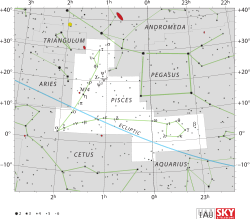Beta Piscium
Beta Piscium (β Piscium, abbreviated Beta Psc, β Psc), formally named Fumalsamakah /ˌfʌməlˈsæməkə/,[10] is a blue-white hued star in the zodiac constellation of Pisces. Its apparent magnitude is 4.40,[2] meaning it can be faintly seen with the naked eye. Based on parallax measurements taken during the Hipparcos mission, it is about 410 light-years (125 parsecs) distant from the Sun.[1]
 | |
| Observation data Epoch J2000 Equinox J2000 | |
|---|---|
| Constellation | Pisces |
| Right ascension | 23h 03m 52.61349s[1] |
| Declination | +03° 49′ 12.1662″[1] |
| Apparent magnitude (V) | +4.40[2] |
| Characteristics | |
| Spectral type | B6Ve[3] |
| U−B color index | −0.48[4] |
| B−V color index | −0.12[4] |
| Variable type | Suspected[5] |
| Astrometry | |
| Radial velocity (Rv) | 0.0 ± 0.6[6] km/s |
| Proper motion (μ) | RA: 11.76[1] mas/yr Dec.: −9.85[1] mas/yr |
| Parallax (π) | 7.99 ± 0.22[1] mas |
| Distance | 410 ± 10 ly (125 ± 3 pc) |
| Absolute magnitude (MV) | −1.01[7] |
| Details[3] | |
| Mass | 4.7 M☉ |
| Radius | 3.6 R☉ |
| Luminosity | 523.6[8] L☉ |
| Surface gravity (log g) | 4.0 cgs |
| Temperature | 15500 K |
| Rotational velocity (v sin i) | 90 ± 15 km/s |
| Other designations | |
| Database references | |
| SIMBAD | data |
Nomenclature
β Piscium (Latinised to Beta Piscium) is the star's Bayer designation.
It bore the traditional name Fum al Samakah from the Arabic فم السمكة fum al-samakah "mouth of the fish" (compare Fomalhaut).[11][12] In 2016, the IAU organized a Working Group on Star Names (WGSN)[13] to catalog and standardize proper names for stars. The WGSN approved the name Fumalsamakah for this star on 1 June 2018 and it is now so included in the List of IAU-approved Star Names.[10]
In Chinese, 霹靂 (Pī Lì), meaning Thunderbolt, refers to an asterism consisting of Beta Piscium and Gamma, Theta, Iota and Omega Piscium. Consequently, the Chinese name for Beta Piscium itself is 霹靂一 (Pī Lì yī, English: the First Star of Thunderbolt).[14]
Properties
Beta Piscium is a Be star,[9] a special class of B-type stars with emission lines in their spectra. With a spectral type of B6Ve[3] its mass is estimated to be about 4.7 M☉, and its radius is about 3.6 R☉.[3] It is suspected to be a variable star.[5] Beta Piscium is radiating 524[8] times the Sun's luminosity from its photosphere at an effective temperature of 15,500 K.[3] The star has a high rate of spin, showing a projected rotational velocity of around 90 km/s.[8]
References
- van Leeuwen, F.; et al. (2007). "Validation of the new Hipparcos reduction". Astronomy and Astrophysics. 474 (2): 653–664. arXiv:0708.1752. Bibcode:2007A&A...474..653V. doi:10.1051/0004-6361:20078357.
- Ducati, J. R. (2002). "VizieR Online Data Catalog: Catalogue of Stellar Photometry in Johnson's 11-color system". CDS/ADC Collection of Electronic Catalogues. 2237. Bibcode:2002yCat.2237....0D.
- Jones, C. E.; Tycner, C.; Sigut, T. A. A.; Benson, J. A.; Hutter, D. J. (2008). "A Parameter Study of Classical Be Star Disk Models Constrained by Optical Interferometry". The Astrophysical Journal. 687: 598–607. arXiv:0807.1515. Bibcode:2008ApJ...687..598J. doi:10.1086/591726.
- Crawford, D. L.; Barnes, J. V.; Golson, J. C. (1971). "Four-color, Hbeta, and UBV photometry for bright B-type stars in the northern hemisphere". The Astronomical Journal. 76: 1058. Bibcode:1971AJ.....76.1058C. doi:10.1086/111220.
- Samus, N. N.; Durlevich, O. V.; et al. (2009). "VizieR Online Data Catalog: General Catalogue of Variable Stars (Samus+ 2007-2013)". VizieR On-line Data Catalog: B/gcvs. Originally Published in: 2009yCat....102025S. 1. Bibcode:2009yCat....1.2025S.
- Gontcharov, G. A. (2006). "Pulkovo Compilation of Radial Velocities for 35 495 Hipparcos stars in a common system". Astronomy Letters. 32 (11): 759–771. arXiv:1606.08053. Bibcode:2006AstL...32..759G. doi:10.1134/S1063773706110065.
- Anderson, E.; Francis, Ch. (2012), "XHIP: An extended hipparcos compilation", Astronomy Letters, 38 (5): 331, arXiv:1108.4971, Bibcode:2012AstL...38..331A, doi:10.1134/S1063773712050015.
- Zorec, J.; Royer, F. (January 2012), "Rotational velocities of A-type stars. IV. Evolution of rotational velocities", Astronomy & Astrophysics, 537: A120, arXiv:1201.2052, Bibcode:2012A&A...537A.120Z, doi:10.1051/0004-6361/201117691.
- "* bet Psc". SIMBAD. Centre de données astronomiques de Strasbourg. Retrieved 30 April 2017.
- "Naming Stars". IAU.org. Retrieved 18 June 2018.
- HD-DM-GC-HR-HIP-Bayer-Flamsteed Cross Index, Kostjuk 2002, refer to table3.dat
- Allen, Richard Hinckley (1963) [1899]. Star Names: Their Lore and Meaning (Reprint ed.). New York, NY: Dover Publications Inc. p. 343. ISBN 0-486-21079-0.
- "IAU Working Group on Star Names (WGSN)". Retrieved 22 May 2016.
- (in Chinese) AEEA (Activities of Exhibition and Education in Astronomy) 天文教育資訊網 2006 年 7 月 8 日